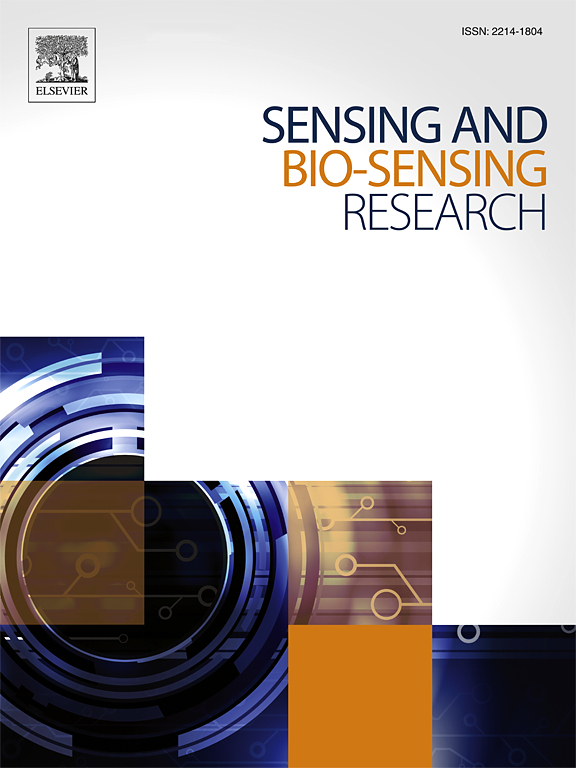Design of a polarization insensitive SPR biosensor for malaria and cancer detection
IF 4.9
Q1 CHEMISTRY, ANALYTICAL
引用次数: 0
Abstract
A polarization-insensitive photonic crystal fiber (PI-PCF) based surface plasmon resonance (SPR) biosensor is designed and analyzed for multianalyte detection. In this work, a simple symmetrical structure is designed using only eight circular-shaped air holes, which makes it not only polarization-insensitive (PI) but also fabrication friendly and reliable. Tantalum pentaoxide (Ta2O5) is used with gold (Au) as the plasmonic material to increase SPR excitation, solve adhesion issues, and minimize the reliance on gold. The analytes are placed on the periphery to facilitate the operation of the sensor. The numerical investigations are conducted using the full-vector finite element method (FEM) based COMSOL Multiphysics software to obtain modal solutions (effective refractive index, field distribution) of core and plasmonic modes of the sensor structure. By optimizing its structural parameters, the sensor has demonstrated a maximum wavelength sensitivity (WS) of 65,000 nm/RIU, amplitude sensitivity (AS) of 3709.66 RIU−1, and figure of merit (FOM) of 1160.71 RIU−1, sensor resolution (SR) of 1.53 × 10−6 RIU, for both x and y-polarizations to detect unknown analyte refractive indices (RIs) from 1.28 to 1.42. Furthermore, the sensor can be used to detect different phases of malaria disease, including ring, schizont and trophozoite phases; it shows the WS of 10,000 nm/RIU for the ring phase and the AS of 2042.77 RIU−1 for the trophozoite phase. Moreover, it can detect six distinct varieties of cancer cells, with WS of 7857.14 nm/RIU for breast (MCF-7) and AS of 5281.01 RIU−1 for cervical (HeLa). The sensor's sensitivity is not significantly affected by air hole dimensions, ensuring high structural tolerance. Its exceptional performance and favorable manufacturing likelihood make it a valuable candidate for biological, biomedical, and biochemical analyte sensing application.
用于疟疾和癌症检测的偏振不敏感SPR生物传感器的设计
设计并分析了一种基于偏振不敏感光子晶体光纤(PI-PCF)的表面等离子体共振(SPR)生物传感器,用于检测多种分析物。在这项工作中,设计了一个简单的对称结构,仅使用八个圆形气孔,使其不仅偏振不敏感(PI),而且制造友好和可靠。五氧化二钽(Ta2O5)与金(Au)一起用作等离子体材料,以增加SPR激发,解决粘附问题,并最大限度地减少对金的依赖。分析物被放置在外围以方便传感器的操作。采用基于COMSOL Multiphysics软件的全矢量有限元法(FEM)进行数值研究,得到了传感器结构的核心和等离子体模态(有效折射率、场分布)的模态解。通过优化结构参数,该传感器的最大波长灵敏度(WS)为65,000 nm/RIU,振幅灵敏度(AS)为3709.66 RIU−1,质量因数(FOM)为1160.71 RIU−1,传感器分辨率(SR)为1.53 × 10−6 RIU, x偏振和y偏振均可检测到未知分析物的折射率(RIs)为1.28 ~ 1.42。此外,该传感器可用于检测疟疾疾病的不同阶段,包括环体、分裂体和滋养体阶段;环相的WS为10,000 nm/RIU,滋养体相的AS为2042.77 RIU−1。此外,它可以检测6种不同类型的癌细胞,乳腺癌(MCF-7)的WS为7857.14 nm/RIU,宫颈癌(HeLa)的AS为5281.01 RIU−1。传感器的灵敏度不受气孔尺寸的显著影响,保证了高的结构公差。其卓越的性能和良好的制造可能性使其成为生物,生物医学和生化分析物传感应用的有价值的候选者。
本文章由计算机程序翻译,如有差异,请以英文原文为准。
求助全文
约1分钟内获得全文
求助全文
来源期刊

Sensing and Bio-Sensing Research
Engineering-Electrical and Electronic Engineering
CiteScore
10.70
自引率
3.80%
发文量
68
审稿时长
87 days
期刊介绍:
Sensing and Bio-Sensing Research is an open access journal dedicated to the research, design, development, and application of bio-sensing and sensing technologies. The editors will accept research papers, reviews, field trials, and validation studies that are of significant relevance. These submissions should describe new concepts, enhance understanding of the field, or offer insights into the practical application, manufacturing, and commercialization of bio-sensing and sensing technologies.
The journal covers a wide range of topics, including sensing principles and mechanisms, new materials development for transducers and recognition components, fabrication technology, and various types of sensors such as optical, electrochemical, mass-sensitive, gas, biosensors, and more. It also includes environmental, process control, and biomedical applications, signal processing, chemometrics, optoelectronic, mechanical, thermal, and magnetic sensors, as well as interface electronics. Additionally, it covers sensor systems and applications, µTAS (Micro Total Analysis Systems), development of solid-state devices for transducing physical signals, and analytical devices incorporating biological materials.
 求助内容:
求助内容: 应助结果提醒方式:
应助结果提醒方式:


